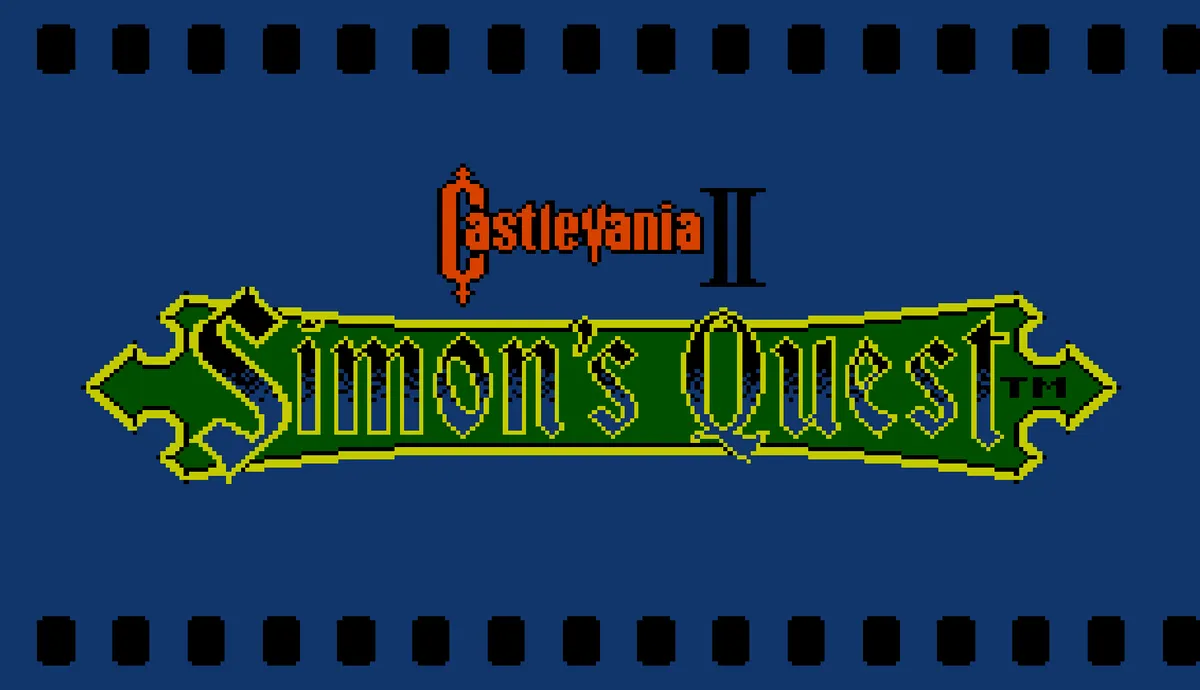There’s a very long list of video games that I’ve picked up, played for an hour or so, and then got either completely bored or frustrated with. Some of these are games that many people really seem to love. Maybe it’s a product of the fact that video games were expensive, and most kids those days just had to make do with the few games we had.
Castlevania II: Simon’s Quest may be at the top of this list for me. Back when an NES was sitting under every television, it seemed like lots of people owned this game, but nobody seemed to really love it.
Castlevania was a name everybody knew, and as games of the era went, the original wasn’t all that frustrating. It was a game that got easier with practice, and while it had some peculiarities in the controls and hit detection, it didn’t feel unfair or “cheap” like so many others did. I played through it again before playing Simon’s Quest for this review. Other than stairs, and the fact that it always feels (and looks) like Simon is walking through molasses, the controls are pretty good. I think it holds up well for a game from 1986.
Simon’s Quest is more — let’s say — complicated. I would guess that I’ve given this game a go at least five times over the years, probably more. Despite repeated attempts, I’ve never before made it much more than an hour or so into the game. Anybody can get to the first castle, but that’s where things really begin to fall apart.
The game mechanics are mostly well-executed, but not perfect. The idea of finding Dracula’s body parts and other relics in order to make your way to Castlevania and destroy the vampire is really good. The non-linear gameplay encourages exploration, although the game’s complete lack of wayfinding adds unnecessary difficulty. Even something resembling the very basic map in The Legend of Zelda would have been a huge benefit to the player. So many places in the game are referred to by name, but there’s almost no way to know if you’re in these places or not. An NPC in town that says “Welcome to Jova” or something like that would have been a huge benefit.
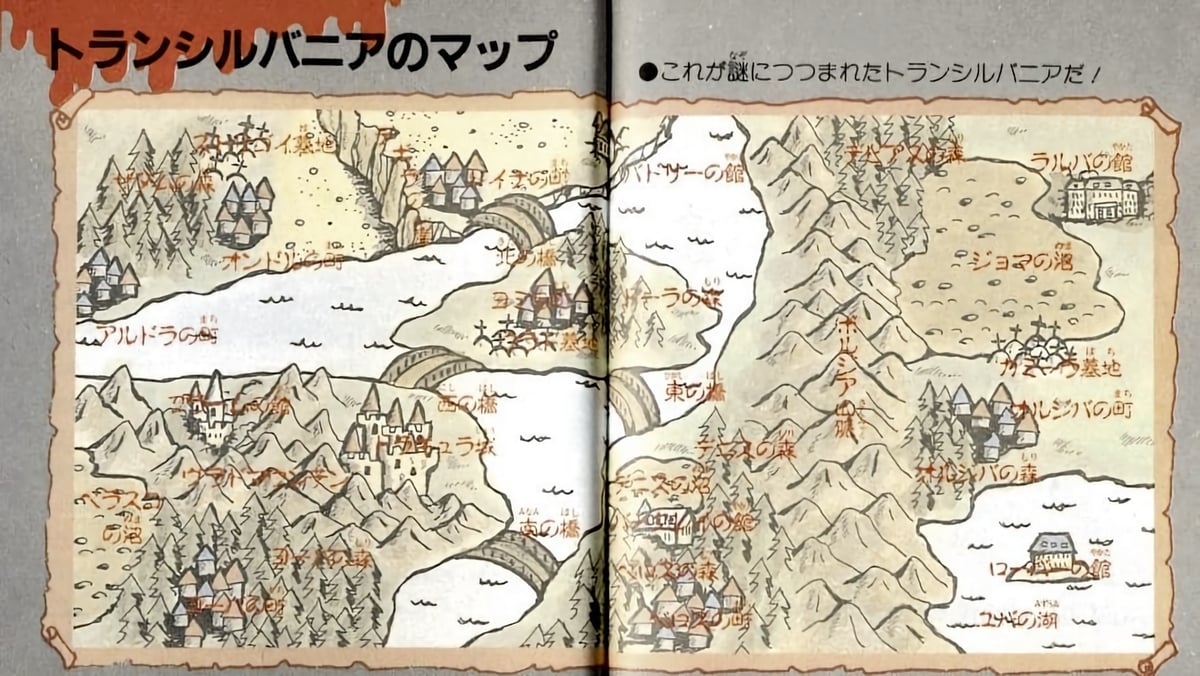
Japan got this map in the game manual. I’m sure it was better than nothing.
The lack of wayfinding affordances is probably the biggest problem with the mechanics, but it’s far from the most unforgivable sin of this game.
Hidden items are also a source of frustration. There are clues placed completely randomly throughout the game. Playing Castlevania, it quickly becomes second nature to take a swing at random blocks and walls with your whip. After all, you never know where a pork chop might be hidden. In this game, there are no pork chops. The only way to refill your health meter is to visit a church or level up, which removes the primary motivation for hitting random blocks.
There’s two problems with how Simon’s Quest handles hidden items. First, you need to use the holy water to find things hidden in blocks, which means you need to have it equipped. It’s not an effective weapon, so it’s hardly a given that you would keep it equipped. Second, the chances of finding something useful are virtually zero. “Dracula’s nail may solve the evil mystery” is not a particularly useful piece of information.
The graveyard duck
The useless random information is just one aspect of a bigger problem. Even if everything was well written and perfectly formatted, the clues just don’t make sense. For some reason, the designers thought it would make sense to have people in the game lie to you. That might actually be fine if they gave you some indication that they’re lying, but even the true information doesn’t make sense. Playing this back in the day, I think people just didn’t pay any attention to what the NPCs said, because none of it was useful. Most reasonable people — the children likely to be playing it especially — would just assume that they didn’t understand.
For as delicately as companies were supposedly handling their reentry into the U.S. video game market after the 1983 crash, Konami seemed perfectly fine with dumping garbage on American players. There’s really no shortage of articles on the internet that take a well-deserved dump on this game. More knowledgeable people have written extensively on the issues with the translation from Japanese to English. One of the most infamous confusing lines in the game isn’t even poorly translated — it was confusingly written even in Japanese.
But other than that, how’s the game?
I think it’s fair to say that the problems with this game aren’t technical; they’re human. Everything wrong with this game was easily preventable. All those glaring problems aside, I do think there’s a lot to like about this game. The actual gameplay isn’t frustrating like many games of the era. The controls and hit detection aren’t bad. In fact, it seems like the hitbox on items is actually quite generous, allowing you to pick up hearts that look too high to jump to or are embedded in walls. Simon also feels slightly less glued to the ground than in Castlevania to me, so it does have some improvements over the original.
One easy to miss aspect of this game is the fact that it doesn’t really have traditional bosses. You get through the first few mansions without ever encountering a boss, until suddenly you meet Death in Brahm’s Mansion. But things are a little differently than normal bosses. They look and behave like bosses, but they respawn when you reenter their room like every other enemy in the game. The music doesn’t change when you encounter them, and they don’t even have life meters. You don’t have to defeat them to clear the mansion, but one drops an items that you need to enter Castlevania, and the other drops a weapon that makes Dracula much easier to kill. All of the bosses, including Dracula himself, are ludicrously easy to defeat, but in this game the focus is supposed to be on exploration, not cheap boss fights.
Being 9 or 10 years old and playing this game, the source of what made it so frustrating wasn’t obvious. It was just an annoying game that made no sense, but one that I really wanted to like. I don’t have a lot of patience for terrible translations of old games these days, but luckily there’s a solution.
When I wrote that I was going to be playing the Nintendo Power cover games, my friend Jim mentioned the Simon’s Redaction ROM hack. This hack was a lifesaver. I played through the game twice — once on the original, and once with Simon’s Redaction. I leaned pretty heavily on the Nintendo Power and a walkthrough in both cases, but less so the second time around. Simon’s Redaction makes a number of improvements to the source material, mainly by fixing the nonsense text, removing all of the lies that people tell you, and adding dialogue to help you figure out where you are.
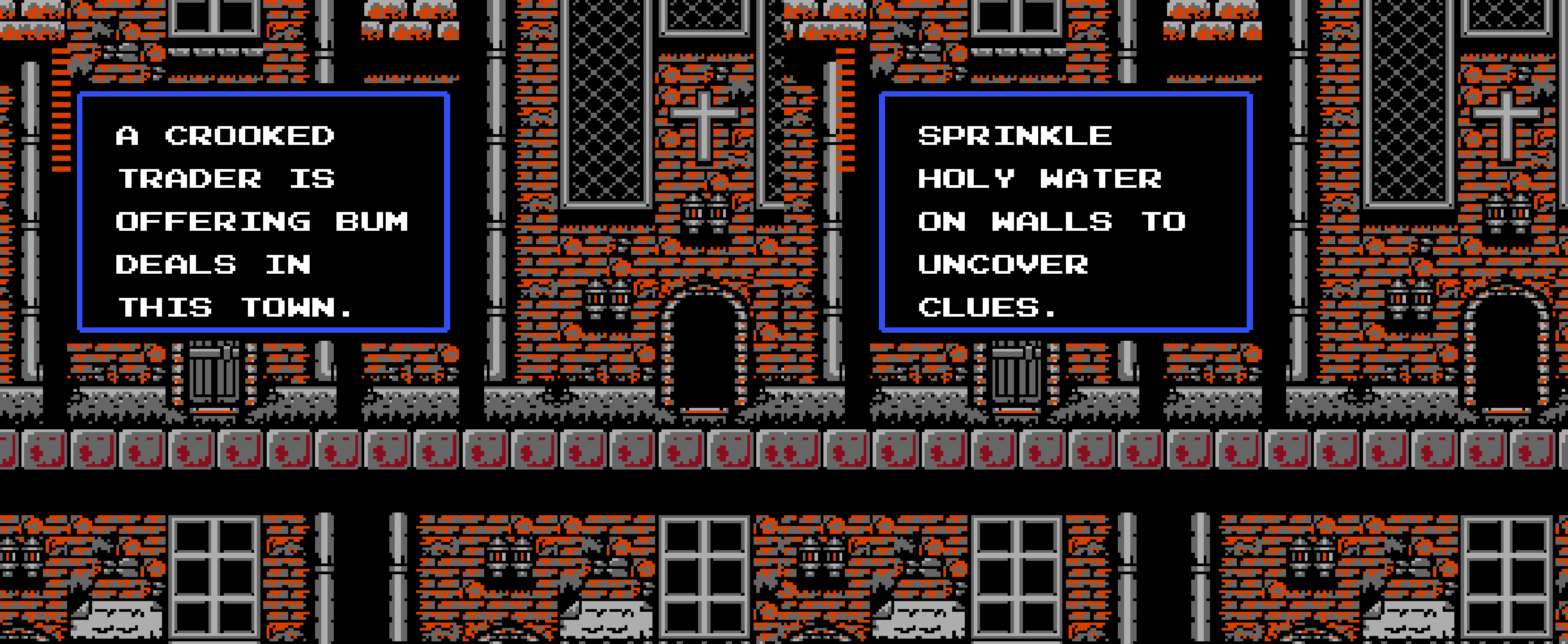
Only one of these is useful.
If you’re looking for a more fully-featured improvement, the Castlevania II Retranslation adds much more, including that sorely missing map and the save feature from the Famicom Disk System version. It also keeps the lies, but at least they’re no longer inscrutable nonsense. The developer has an in-depth breakdown comparing the translations of the various versions, including his improved version based on the original Japanese. It’s actually pretty interesting stuff with commentary that helps explain the crazy translation.
A new genre
At the time it was released, and even for many years afterwards, Simon’s Quest stuck out like a sore thumb among the three NES Castlevania games, and even the two Super Nintendo releases. In hindsight, it helped spawn an entire genre. Simon’s Quest, along with Metroid, is an early example of a “Metroidvania” game, a genre that wouldn’t even receive a name for another decade. Oddly enough, none of the other Castlevania games for the NES or even the Super NES really qualify for this genre. The term wouldn’t even be coined until after Super Metroid and Castlevania: Symphony of the Night were released.
Simon’s Quest may feel unique among early Castlevania titles, but it actually builds upon concepts Konami introduced in an earlier game that never saw a U.S. release. Vampire Killer looks and sounds nearly identical to the original Castlevania in many respects, but with vast differences in the play mechanics. In this game, released for the MSX2 computer just a month after Castlevania hit the Famicom Disk System, Simon Belmont wanders Castlevania in search of keys and treasures to help make his way to destroy Dracula.

Vampire Killer on the MSX2
That sounds pretty similar to Castlevania, but in practice it’s quite different. The levels require backtracking to find the keys before you can open the door to advance, and the levels don’t scroll — they’re divided up into individual screens. You can advance by going left or right, as well as up and down stairs between screens. Going left or right eventually wraps around, a necessity for accessing many areas and items. For my money, Vampire Killer feels a lot more like Pitfall than a Castlevania game. While it’s fun to see a very different vision for something so familiar, the game is next to impossible. It’s a worthwhile play for only the most hardcore Castlevania fans. It’s hard to know for sure if Vampire Killer was the true vision for Castlevania that could just never be realized on the NES hardware, but it certainly laid the groundwork for Simon’s Quest and later titles.
Also in this issue
And now comes the part where I look at what else appeared in the September–October 1988 issue of Nintendo Power.
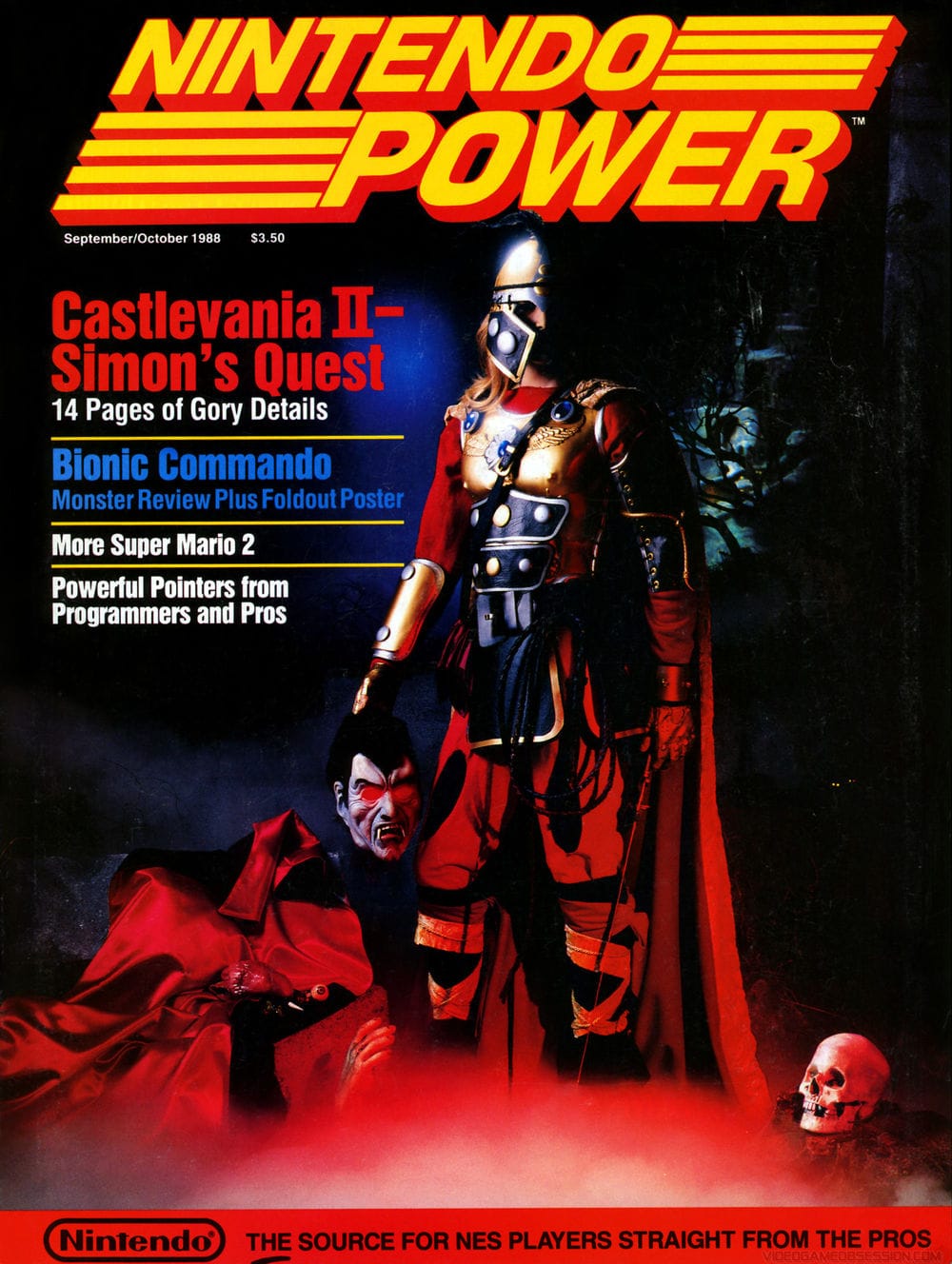
Simon’s Quest
The feature covering this month’s cover game was pretty in-depth. For a game as inscrutable as this, they do a good job of introducing how things work and the mechanics of the game. The article isn’t quite like the wall-of-text video game walkthroughs that have dominated many game sites for the last 15 years or so. Nintendo seemed to want to make people think at least a little bit, which was good because the article only takes you about halfway through the game. Crucially, the issue provided a map, though it wasn’t terribly useful. The art accompanying the piece is hilarious and I love it. The cover of the game is also notable, because Nintendo apparently received complaints that Dracula’s severed head gave kids nightmares.
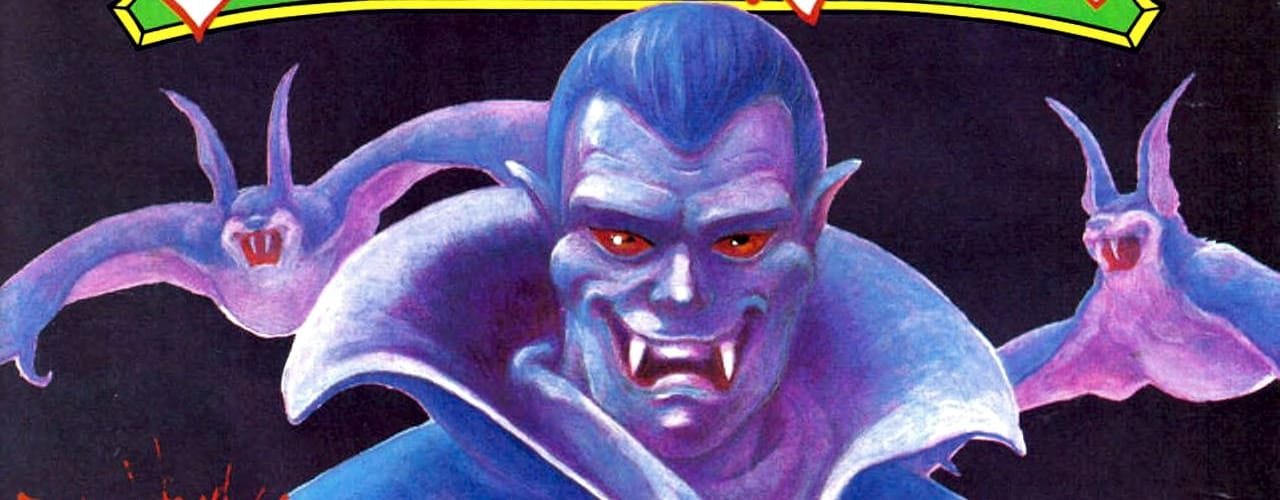
Nintendo Power
Watch out for this scary guy and his bat buddies!
Other featured games
- The issue also features a huge spread on Bionic Commando, which is another game I should put on my to-play list. I’ve never played this game, but I have beaten it once. A friend was playing a ROM on a PSP many years back, and asked me to take a shot at the last boss, which was giving him trouble. I did it on the first try and then saw Hitler’s head explode, which I was absolutely not expecting.
- Continuing on, there are several pages devoted to Life Force, which was never my cup of tea. They follow up the first issue’s Super Mario Bros. 2 feature with maps and tips for the next three levels. There’s also a pretty sparse feature covering Renegade, and an article on R.C. Pro-Am.
- Golgo 13: Top Secret Episode gets a long, but not super in-depth feature. I was always intrigued by these games, but never had the opportunity to play either this one or its sequel, The Mafat Conspiracy.
- There’s a short feature on Blaster Master, which I actually did own, and is another early example of the Metroidvania genre. I owned this game for 31 years before I finally beat it earlier this year. I was kind of surprised by how far I got into the game back in the day, considering the difficulty. This game had great potential, but it was marred by some unnecessarily dumb mechanics. The worst was your weapon — which you had to find power ups for — immediately losing that power if you took a hit. Adding in the ability to save with OpenEmu added some fun back in.
Highlights from Counselor’s Corner and Classified Information
- Kid Icarus, which is yet another game I’ve never played but should, appears in both Counselor’s Corner and Classified Information.
- There are some tips on Renegade, which would have made sense to put into the weirdly thin article on this very game.
- There are also a few tips on Kid Niki: Radical Ninja, which I’ve heard of but was turned off by the terrible name alone.
- They also cover some real basics for Super Mario Bros., The Legend of Zelda, and Metroid, which seem like tips they’re just trying to get out of the way so they can say they covered them.
Pak Watch and Video Shorts
There were too many upcoming games to mention all of them, but delays for both Zelda II: The Adventure of Link and Teenage Mutant Ninja Turtles are mentioned. Some other highlights include Jackal (because everything from Konami was a big deal), 1943 (likewise for Capcom), Hudson’s Adventure Island, Paperboy, Friday the 13th, Wrestlemania, Skate or Die, California Games, and John Elway’s Quarterback.
Random bits
The NES Journal covers the announcement of the Power Pad and Power Set, which to me always felt like something that came out later, but I’ve already established that I have a pretty spotty memory for these things. NES Journal also contains a profile of the founders of Rare, which would go on to be pretty significant for Nintendo.
The Fall Television Preview mentions the TV adaptation of Dirty Dancing, but I think the mention of the 1988 Writers Guild of America strike is much more interesting. I can’t help but wonder how much the lack of new television shows helped Nintendo at this time.
The Celebrity Profile in this issue covers NFL players Eric Dickerson, Ron Morris, and Sean Jones. Ron Morris retired in 1995 after a career-ending knee injury, Sean Jones won Super Bowl XXXI playing for the Packers, and Eric Dickerson still holds the record for rushing yards in a single NFL season. Not too shabby.
And finally
Playing all the way through Simon’s Quest for the first time, and understanding things better now, it actually feels like I’d pick this game up again sometime in the future. I’d mostly likely play through the Retranslation ROM hack to experience a version that is both more idealized and closer to the source material. I’m glad I was finally able to cross this game off my list.
Next in the series is Track & Field II, which I’m sure is a timeless classic.
